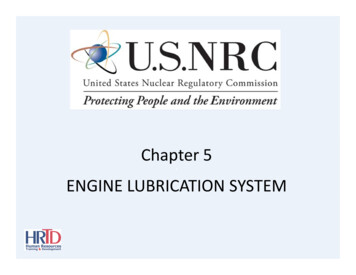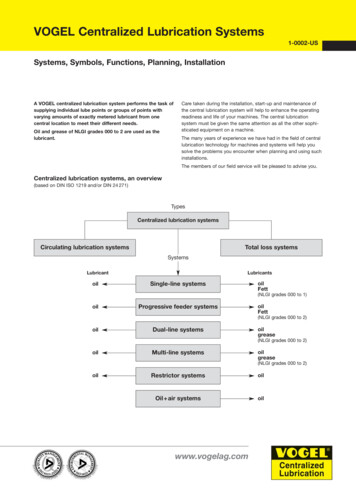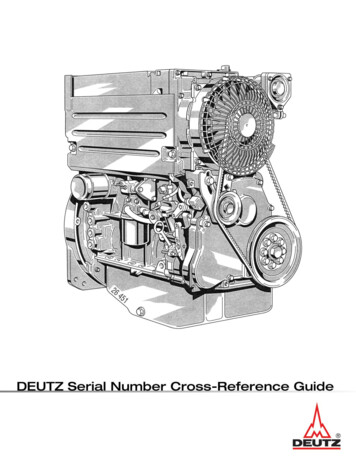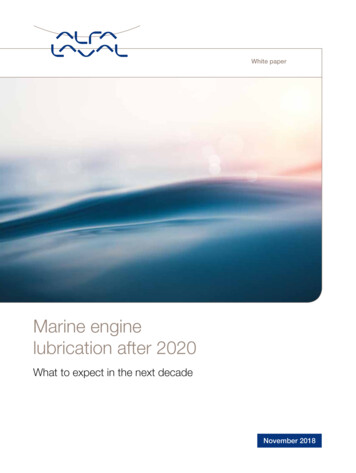
Transcription
Chapter 5*ENGINE LUBRICATION SYSTEM
Learning Objectives:As a result of this chapter, you will be able to:1. Define lubrication and the types of friction.2. State the function of the diesel engine lubricationsystem.3. Identify the major components of the typical dieselengine lubrication system and trace the flow path ofthe lubricating oil through the engine.4. State the purpose and describe the operation of thelubrication oil keep warm and pre-lube system(s) asare commonly used on nuclear plant diesel engines.
Lubrication Fundamentals¾ Lubrication is defined as the application of lubricantsto minimize friction between moving contact surfaces.¾ Friction is the force that acts at the contact surfacebetween two bodies which causes resistance to theirrelative motion.¾ Forced movement of adjacent surfaces can wear awaythe surfaces and also create heat as illustrated inFigure 5-1. Types of friction are illustrated in Figures5-2 and 5-3.
Figure 5-1Frictional Surfaces
Figure 5-2Types of Friction
Figure 5-3 Rolling Friction
Lubrication to achieve fluid friction is accomplishedby lubricant wedge formation with laminar flow ofthe lubricant between the surfaces, as illustrated inFigures 5-4 and 5-55-5. Application of this principle tothe crankshaft is illustrated in Figure 5-6.
Figure 5-4 Laminar Action
Figure 5-5 Wedge Formation
Figure 5-6Shaft and Bearing
Lubrication Functions¾ Maintain a film of lubrication betweenmoving parts.¾ Create a gas tight seal between the pistonrings and cylinder wall.¾ Remove and dissipate heat.¾ Keep surfaces clean
Lubricants’ properties must be as specifiedby the EDG manufacturer including:¾ Viscosity¾ Viscosity Index (no multi-viscosity oils)¾ Pour Point¾ Oxidation Resistance – TBN/TAN numbers¾ Naphthenic versus Paraffinic Lubracants¾ A Specific Manufacturer’s Lubricant (in some cases)
A typical lube oil circulating and cooling system isshown in Figure 5-7. Details of some of theircomponentst are shownhon FiFigures 55-8,8 5-9,5 9 5-10,5 10and 5-12.
Figure 5-7 Lube Oil Circulating and Cooling System
Figure 5-8Lubricating OilPump
Figure 5-9Lubricating OilFilters
Figure 5-10 Lubricating Oil Cooler
Figure 5-11Pressure ReliefValve
Figure 5-12 Pressure Regulating Valve
A typical lube oil system with keepwarm added isshown in Figure 5-13. Lubrication and cooling forthe Pielstick engine bearings, pistons, cylinders,cylinder heads,heads and rocker arms are illustrated inFigures 5-14 and 5-15.
Figure 5-13 Lube Oil System with Keepwarm Added
Figure 5-14Pielstick EngineLube Oil Flow
Figure 5-15Pielstick ValveRocker Flow
Lube Oil System MonitoringTypically, the pressures and temperatures of the fluids inthe lubrication system will be monitored and displayed onthe engine control panel. A few other items in the lubeoil system may also be monitored, as follows:¾ Crankcase pressure (vacuum). Because the oil is containedin the crankcase of the engine, monitoring that space mayindicate a problem in the engine. A special sensor fordoing so is shown in Figure 5-16.¾ Main bearings may also be monitored for temperature. Asensor for that purpose is shown in Figure 5-17.
Figure 5-16 Diaphragm-Type Crankcase Pressure Monitoring Switch
Figure 5-17 Bearing Temperature Probe
END OF CHAPTER 5
Figures 5Figures 5-4and54 and 5-5 Application of this principle to5. Application of this principle to the crankshaft is illustrated in Figure 5-6. Figure 5-4 Laminar Action. Figure 5-5 Wedge Formation. Figure 5-6 Shaft and Bearing. Lubrication Functions










